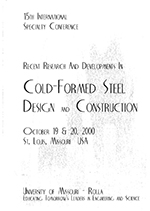Session Dates
19 Oct 2000
Abstract
The latest edition of the American Iron and Steel Institute (AISI) Specification for the Design of Cold-Formed Steel Structural Members was published in 1996 (AISI, 1996). Design rules are presented in both allowable stress design (ASD) and load and resistance factor design (LRFD) formats. The LRFD rules of the latest AISI Specification form the basis of the Australian/New Zealand Standard AS/NZS 4600:1996 Cold-Formed Steel Structures (SA/SNZ, 1996), which was published in late 1996 and supersedes the corresponding Australian permissible stress Standard AS 1538-1988. One of the main applications of cold-formed steel is purlins and girts in metal roof and wall systems. The design rules for these structural members have been refined over the years and procedures are now available which allow the effects of the sheeting restraint, lapped regions, and height of load application to be incorporated. Nevertheless, unlike AS/NZS 4600: 1996, the AISI Specification does not explicitly allow the use of advanced numerical techniques such as rational elastic buckling analyses within Clause C3 .1.2 to improve the accuracy and reliability of the design procedures. This paper summarises the existing two approaches to puriin design (herein termed the C-factor approach and the R-factor approach) in the AISI Specification, and presents a third approach based on the use of elastic rational buckling analysis to determine the lateral buckling strength of the purlin system. The relative merits and drawbacks of each approach are discussed. The importance of distortional buckling as a failure mode to be considered (currently neglected in the AISI Specification but included in AS/NZS 4600:1996) is also highlighted. The ultimate load capacities computed using the various design models are compared with test results obtained from vacuum rig testing at the University of Sydney over a period of more than 10 years. The use of rational elastic buckling analysis in conjunction with the existing AISI beam strength curve is found to be effective as a means of assessing the lateral buckling strength of puriin systems.
Department(s)
Civil, Architectural and Environmental Engineering
Research Center/Lab(s)
Wei-Wen Yu Center for Cold-Formed Steel Structures
Meeting Name
15th International Specialty Conference on Cold-Formed Steel Structures
Publisher
University of Missouri--Rolla
Document Version
Final Version
Rights
© 2000 University of Missouri--Rolla, All rights reserved.
Document Type
Article - Conference proceedings
File Type
text
Language
English
Recommended Citation
Clarke, Murry J. and Hancock, Gregory J., "Purlin Design to AISI LRFD Using Rational Buckling Analysis" (2000). CCFSS Proceedings of International Specialty Conference on Cold-Formed Steel Structures (1971 - 2018). 3.
https://scholarsmine.mst.edu/isccss/15iccfss/15iccfss-session8/3
Purlin Design to AISI LRFD Using Rational Buckling Analysis
The latest edition of the American Iron and Steel Institute (AISI) Specification for the Design of Cold-Formed Steel Structural Members was published in 1996 (AISI, 1996). Design rules are presented in both allowable stress design (ASD) and load and resistance factor design (LRFD) formats. The LRFD rules of the latest AISI Specification form the basis of the Australian/New Zealand Standard AS/NZS 4600:1996 Cold-Formed Steel Structures (SA/SNZ, 1996), which was published in late 1996 and supersedes the corresponding Australian permissible stress Standard AS 1538-1988. One of the main applications of cold-formed steel is purlins and girts in metal roof and wall systems. The design rules for these structural members have been refined over the years and procedures are now available which allow the effects of the sheeting restraint, lapped regions, and height of load application to be incorporated. Nevertheless, unlike AS/NZS 4600: 1996, the AISI Specification does not explicitly allow the use of advanced numerical techniques such as rational elastic buckling analyses within Clause C3 .1.2 to improve the accuracy and reliability of the design procedures. This paper summarises the existing two approaches to puriin design (herein termed the C-factor approach and the R-factor approach) in the AISI Specification, and presents a third approach based on the use of elastic rational buckling analysis to determine the lateral buckling strength of the purlin system. The relative merits and drawbacks of each approach are discussed. The importance of distortional buckling as a failure mode to be considered (currently neglected in the AISI Specification but included in AS/NZS 4600:1996) is also highlighted. The ultimate load capacities computed using the various design models are compared with test results obtained from vacuum rig testing at the University of Sydney over a period of more than 10 years. The use of rational elastic buckling analysis in conjunction with the existing AISI beam strength curve is found to be effective as a means of assessing the lateral buckling strength of puriin systems.



